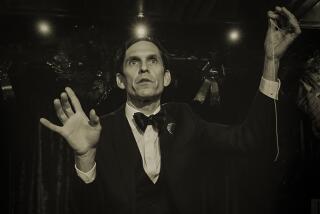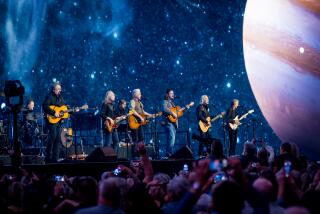The Soleil Also Rises in Vegas : Oddly, the magic of Cirque’s ‘Mystere’ seems to multiply inside a casino even more than under a big top.
LAS VEGAS — When deciding what to do in Las Vegas, Southern Californians might wonder if they can skip “Mystere,” Cirque du Soleil’s extravaganza at Treasure Island, on the Strip. After all, the Cirque often sends a troupe through its usual haunts in Santa Monica, Costa Mesa and (not so often) San Diego. If you’re in Las Vegas for only a few evenings--with so many other entertainments beckoning your credit card--why see something that you can see at home?
Many Cirque du Soleil fans are so devoted that they wouldn’t be deterred for a moment by such a thought--and yes, their devotion is rewarded, judging from a look at a recent overhaul of the 2-year-old show. Still, heretical doubts might hit even these fans as they actually try to enter “Mystere.”
Within the Treasure Island hotel, the Cirque theater is located directly opposite the main entrance--so you must trudge through a vast, smoky, clanging casino, following directions on the signs, to get to “Mystere.” You may wish you had a treasure map. This journey can’t compare to the approach to the Cirque’s big top on the Santa Monica beach, where the lights of the pier twinkle as the soleil drops into the Pacific.
Once one passes through the portals of the “Mystere” experience, however, the location of the show begins to make more sense. An escape into Cirque du Soleil fantasy is more of a contrast with the surrounding environment in Las Vegas than it is on the Santa Monica beachfront--where the ocean itself can stir up some of the same timeless, elemental thoughts that Cirque shows often evoke. On the Strip, the surrounding sea consists of casinos and inexpensive buffets, and “Mystere” is indeed a treasure island.
Not that all ties are severed with the outside world. Before you even enter the hotel, check out the pirate ship moored out front (used for a brief, staged “pirate battle” every 90 minutes from 4 p.m. on through the evening). Perhaps it wasn’t intentional, but the backdrop for the “Mystere” stage resembles an abstraction of that ship’s masts and sails. But rather than bring the outside world in, this connection simply feeds the fantasy that you’re embarking on a voyage to a faraway land.
This may make “Mystere” sound unduly solemn. Be assured that the pre-show begins with a burst of rude, slapstick comedy in the audience, similar to the antics that precede other Cirque shows. A troupe of Cirque clowns, dressed like weird ducks, steal popcorn off the trays of audience members who are scurrying to their seats and dump the flaky kernels over the heads or down the backs of other audience members, many of whom seem to be selected for their bald pates. Others among the marauders mimic unsuspecting audience members behind their backs, as they walk to their seats.
A baby carriage with fluorescent-colored wheels is one of the first items to show up on the stage. We also hear sounds of distant babies, and babies will be one of the evening’s central themes. But the show really starts with the drums.
Here is our first big clue that this 1,541-seat theater, built to Cirque specifications, is a more versatile, flexible space than the big tops used when the Cirque tours. Taiko drummers are suspended far over the audience, beating their enormous drums. These aerial drummers are among several recent additions to “Mystere” inaugurated by the show’s new artistic coordinator Pavel Brun. Near the end, the drummers perform a thundering ensemble piece, onstage as well as overhead.
Soon, we get an even more dramatic demonstration of the difference between this largest of the Cirque shows and the others. Parts of the stage move up and down. Throughout the show, the front of the modified thrust stage will sink into what looks like some mist-shrouded netherland, only to rise again bearing some new ambassador or contraption from the deep, all for the purpose of further astonishment.
Access to the area far above the stage appears to be almost as easy in this theater as access to the ground level. Although we see some climbing going on at the front of the stage, many of the aerial artists suddenly appear at the top of the space, as if that were their natural habitat. During the bungee act, as the performers whirl through their paces they look more than ever like wildly spinning angels.
We’re brought down to earth by Francois Dupuis, the principal clown on the evening I attended. Swathed in baby clothes, he’s one of the few performers whose body doesn’t appear to be perfectly toned and conditioned, so audience members can automatically relate to him more easily as one of our own kind. His goal is to bring out the baby in all of us. He bats a huge ball into the audience, where people enthusiastically return the serve, and he climbs out on a high ledge in pursuit of a bottle--that’s actually hung around his neck.
In the evening’s most extended audience participation, Dupuis selects a good sport from the front row, brings him up on stage and induces him, through baby talk and gesture, to change out of his tailored suit, white shirt and tie into baby clothes that match Dupuis’ own outfit. Then the two of them begin squirting the audience with big water pistols.
Another clown act, Alfredo and Adrenaline (James Keylon and Francine Co^te), is a recent addition to “Mystere,” but they were out of commission on the evening I attended due to illness. They recently replaced Wayne Hronek’s “mad professor” act; Hronek periodically takes time off to “go home and carve ducks,” said a Cirque publicist.
Among other recent changes, for those who saw “Mystere” before 1996: Mikhail (Mischa) Matorin--a long-maned, bare-chested man who manipulates a 50-pound aluminum cube while dangling high above the stage--is in; Californians already saw him in the touring Cirque show “Alegria.” He replaced an opening act in which a trio manipulated various shapes and balls; they’ve left to join the next new touring show, which opens April 24 in Montreal.
Brun also changed the last act from a flying trapeze to a high bar. In the latter, described by a Cirque publicist as more dangerous, the bars remain static while the people swing between them. At the performance I attended, a net caught two swingers who missed. It’s an exciting act, though not quite as dazzling as the bungee jumpers or as dangerous as the Korean Plank (teeterboard) act, which looked flawless at the same performance.
Amid all the high flying and jumping, the act that grips attention more than any other is an intensely slow, ground-based hand-to-hand duet between Christophe Suszek and Bogdan Zajac balancing each other’s bodies in bizarre positions in the center of a revolving circular mound. It’s here that Luc Lafortune’s lighting design is at its most extraordinary--the men are first drained of color, then bathed in a greenish-yellow pastel. As they leave the stage escorted by a retinue of men, the ensemble is splotched with a pattern of light. It’s a bewitching effect. As always, much of the magic also comes from Rene Dupere’s music, performed from perches on both sides of the stage.
Unlike other Cirque shows but like most other Vegas shows, “Mystere” lacks an intermission, clocking in at just over 90 minutes. It’s also higher priced than the touring shows, so before the show, some may question whether they’ll get full value.
On the way out, though, no one will doubt that there were plenty of gasps, laughs and action packed into those 90 minutes. The cast is larger (72) than that of a touring show. When all of them come out to take a spectacular final bow, watched over by a massive sad-eyed snail, it’s no mystery why “Mystere” already has attracted 1.5 million visitors: You reenter the din of the casino with an invigorated spirit.
*
“MYSTERE,” Treasure Island hotel, 3300 Las Vegas Blvd., Las Vegas. Dates: Wednesdays to Sundays, 7:30 and 10:30 p.m. Plays indefinitely (but note 1996 dark periods: April 8-11, June 10-18, Aug. 5-8, Oct. 7-10, Dec. 2-14 and 23-25). Prices: $59.95; $29.95 for children under 12. Phone: (800) 392-1999 or (702) 894-7722.
More to Read
Sign up for The Wild
We’ll help you find the best places to hike, bike and run, as well as the perfect silent spots for meditation and yoga.
You may occasionally receive promotional content from the Los Angeles Times.






